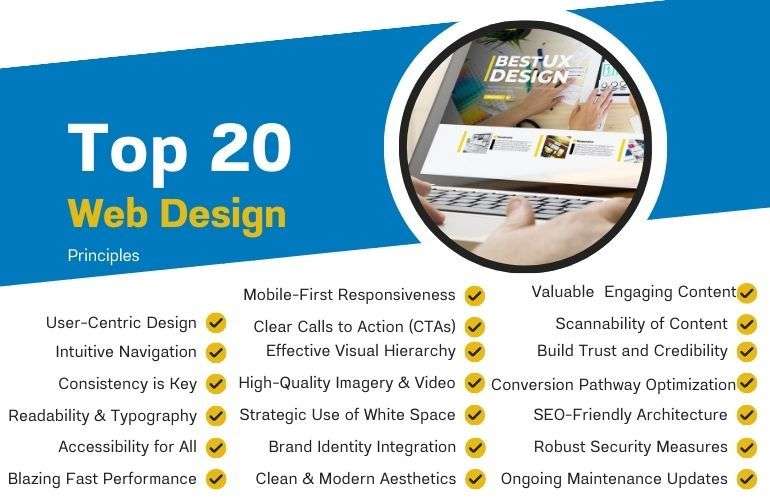
Posted on: May 23, 2025
Top 20 Principles to Follow in Web Design for a Stellar Online Presence
In today's digital-first world, your website is often the first impression potential customers have of your business. It's more than just an online brochure; it's a powerful tool for communication, conversion, and brand building. But with so many websites out there, how do you ensure yours stands out and truly engages your audience?
The answer lies in adhering to fundamental web design principles. At Digiency, we believe that a well-designed website isn't just about aesthetics; it's about functionality, user experience, and achieving your business goals.
Here are 20 essential principles we advocate for creating a website that not only looks great but also performs exceptionally:
The Core Pillars: User Experience (UX) & Usability
1. User-Centric Design
This isn't just a buzzword; it's the foundation. Every design decision, from layout to content placement, should be made with your target user in mind. Understand their journey, anticipate their needs, and design for their satisfaction.
2. Intuitive Navigation
Users should never feel lost. Your website's navigation should be clear, consistent, and easy to understand. Think logical categories, clear menu labels, and a search bar if your site is content-heavy.
3. Consistency is Key
From your brand colors and typography to button styles and interactive elements, maintaining consistency across all pages builds trust and familiarity. It helps users quickly learn how to interact with your site.
4. Readability & Typography
Text needs to be effortless to read. This means selecting legible fonts, ensuring sufficient contrast between text and background, and using appropriate line height and letter spacing. Break up large blocks of text with headings and paragraphs for better flow.
5. Accessibility for All
Design your website to be usable by everyone, regardless of ability. This includes providing alternative text for images, ensuring keyboard navigation, and checking color contrast ratios. An accessible site is a more inclusive site.
6. Blazing Fast Performance
In today's instant gratification world, slow websites are abandoned. Optimize images, leverage browser caching, and minify code to ensure your site loads in mere seconds. Speed directly impacts user satisfaction and SEO.
7. Mobile-First Responsiveness
With a significant portion of web traffic coming from mobile devices, your website must adapt flawlessly to every screen size. A mobile-first approach ensures a superior experience on smaller screens.
8. Clear Calls to Action (CTAs)
Don't leave users guessing. Prominently display clear, actionable CTAs that guide users towards your desired outcome, whether it's "Get a Quote," "Download Now," or "Explore Services."
Visual Appeal & Branding
9. Effective Visual Hierarchy
Guide the user's eye naturally to the most important elements on the page. Use variations in size, color, contrast, and placement to highlight key information and direct attention.
10. High-Quality Imagery & Video
Generic stock photos just won't cut it. Invest in compelling, relevant, and high-resolution images and videos that resonate with your brand and audience. Visuals tell a story faster than words.
11. Strategic Use of White Space
Don't be afraid of empty space! White space (or negative space) around elements improves readability, reduces cognitive load, and helps important content stand out, creating a clean and sophisticated look.
12. Seamless Brand Identity Integration
Your website is an extension of your brand. Ensure your logo, brand colors, typography, and brand voice are consistently woven throughout the site, reinforcing your unique identity.
13. Clean & Modern Aesthetics
While design trends evolve, a clean, uncluttered, and modern aesthetic generally provides a better user experience and conveys professionalism and trustworthiness. Avoid outdated designs that can deter visitors.
Content & Conversion
14. Valuable & Engaging Content
Content is the backbone of your website. Provide high-quality, relevant, and well-written information that addresses your audience's pain points, answers their questions, and provides real value.
15. Scannability of Content
Most users scan web pages rather than reading every word. Use short paragraphs, bullet points, numbered lists, and bolded text to make your content easy to digest and allow users to quickly find what they're looking for.
16. Build Trust and Credibility
Showcase testimonials, client logos, security badges, clear contact information, and privacy policies. These trust signals reassure visitors and encourage them to engage further with your business.
17. Conversion Pathway Optimization
Every element on your website should contribute to your business goals. Design clear conversion pathways, whether it's lead generation, sales, or sign-ups, and constantly optimize them for maximum effectiveness.
Technical & Maintenance Considerations
18. SEO-Friendly Architecture
Design your website with search engines in mind from the ground up. This includes clean code, proper use of heading tags, optimized images, and a logical site structure to improve your search engine rankings.
19. Robust Security Measures
Protect your website and your users' data with SSL certificates, strong passwords, and regular security audits. A secure website builds trust and avoids potential breaches.
20. Ongoing Maintenance & Updates
Your website isn't a "set it and forget it" asset. Regular content updates, software patches, security checks, and performance monitoring are crucial to keep your site functioning optimally and securely in the long run.
Ready to Transform Your Online Presence?
At Digiency, we don't just build websites; we craft digital experiences that drive results. By meticulously applying these 20 principles, we ensure your website is not only visually stunning but also a powerful asset for your business.
Contact Digiency today to discuss how we can help you implement these principles and create a web design that truly makes a difference!